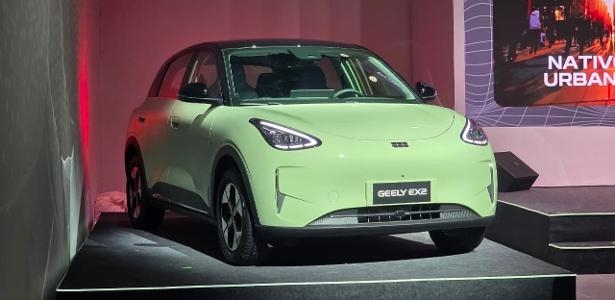Understand how climate change influences economic strategies and the power struggle between the two countries that pollute the planet the most.
%2Fhttps%3A%2F%2Fi.s3.glbimg.com%2Fv1%2FAUTH_59edd422c0c84a879bd37670ae4f538a%2Finternal_photos%2Fbs%2F2025%2Ff%2Fu%2Fn4Zlr2SCOYuGhCankAAg%2Fglobo-canal-4-20251106-2000-frame-164973.jpeg&w=1920&q=100)

How the climate crisis is interfering with the power struggle between the US and China.
You may never have heard of the city of Zhezhong. But it has 13 million inhabitants – more than the largest Brazilian capital. It's an industrial hub. It's to Shanghai what Campinas is to São Paulo.
Would you dare to stroll through one of the world's largest cities like this? When you arrive to catch the bus to work and realize the driver isn't there, you think: " Oh no, this one's going to be late. I'll sit and wait ." But this bus is different. It's not the only one in the leading city in the production of technology for public transportation, with factories so gigantic that nobody walks inside. Just wait a little while. Fasten your seatbelts, the driver has disappeared.
Workers at the world's largest electric bus manufacturer produce both small and large buses that are being tested on the streets.
"There are already 300 of these buses operating in China, which have already traveled more than 4,000 km, and the number of accidents so far is zero," says Wang Zhen, autonomous driving manager.
Buses use sensors and radar to identify obstacles. They don't need gasoline.
Wherever you look in China, you see the country's development program - electrifying everything: 70% of all electric car production is Chinese; 80% of trains are electric; 97% of all buses sold there are electric, as well as two-wheeled vehicles.
"I wanted to buy a combustion engine motorcycle. Foreigners like combustion engines, and I wanted one too, something faster. But I realized I was going to lose it to the police, the police were going to take it from me – and they really do – and that's it, they won't get it anymore," says Professor Pablo Lasalle.
Pablo has lived in Wuhan for ten years. Gasoline-powered motorcycles are simply banned from the city center. So, he got used to it.
"You don't spend money on batteries. Every three days you spend R$1, R$1.50," he says.
Climate change influences economic strategies and the power struggle between the two countries that pollute the planet the most — Photo: Jornal Nacional/Reproduction
But this cheap electricity that fuels Chinese growth is anything but green: 60% of all the energy that charges motorcycles, cars, and buses is generated by coal-fired power plants. That's why China is the world's biggest polluter.
The difference is that they have a plan. The green transition already represents 10% of China's Gross Domestic Product. Six out of ten wind turbines produced in the world are made in China. This also includes gigantic solar farms and hydroelectric dams.
The difference with China is that until very recently they were a poor country. Almost nobody owned a car, for example. It wasn't until 1997 that they opened their first large-scale car factory – half American, half Chinese. Ronaldo Znidarsis was an executive at that company. In his opinion, this Chinese electrification has nothing to do with the environment.
"China made a conscious decision that it did not have the autonomy to have a combustion-powered fleet. Therefore, it does not have sufficient oil resources for the fleet it has and decided to invest in electricity," says Ronaldo Znidarsis, operations director at Zeekr.
Fernando Valle is an energy market analyst.
"China is still the largest importer of oil, is growing as an importer of liquefied natural gas, and is a major consumer of coal. It's less about the renewable aspect and emissions and much more about continuing to grow the country's industrial base," says Fernando Valle, executive director of energy at Hedgeye Risk Management.
72% of all the oil that China consumes is imported. This is a very different reality from that of the United States. On August 27, 1859, the world's first commercial oil well was drilled in the American state of Pennsylvania. It was there that oil as we know it today was born. It replaced muscle power and coal – mainly because it was cheaper – to power cars, airplanes, factories. And later, plastic, fertilizer, medicine, electronics. Black gold.
American oil companies became multinational and began drilling wells around the world : Mexico , Colombia , Venezuela , the Middle East . The U.S. State Department served as an advocate for the United States globally, paving the way for concessions to proceed smoothly by signing treaties, building military bases, and forging strategic alliances.
Saudi Arabia : The Americans built all the infrastructure – pipelines, export terminals. And the American Navy guaranteed security along the routes. In 1974, the masterstroke came in a secret meeting. In exchange for weapons and military protection, the Saudis agreed to buy and sell using only one currency: the American dollar. Soon, all oil transactions on the planet were mandatorily made with the American currency. It was the beginning of an era that lasts to this day: the era of the petrodollar.
Climate change influences economic strategies and the power struggle between the two countries that pollute the planet the most — Photo: Jornal Nacional/Reproduction
Transactions in dollars must necessarily go through American banks in New York. And any country that wanted to buy oil had to have savings in dollars. Many countries had to take out loans with conditions favorable to the Americans. It's no joke the power that oil had in giving Americans the power they have today.
"All oil transactions are done in dollars. Oil is priced in dollars. And there's this correlation between the price of oil and the dollar. The United States has this monetary control," says Fernando Valle.
It was the birth of the world we live in. But the world we live in is changing. The climate changes that frighten us every day have other consequences for the economy that we can't even begin to calculate yet.
Greenland : a frozen island near the North Pole. The winter there is so harsh that the sea freezes, and Greenland then touches Canada on one side and Iceland on the other – or at least that's how it was until now. Greenland is warming three times faster than the rest of the planet. This is completely changing the importance of ports there. Because, in the past, the entire sea froze. Now, even in winter, ships can stop. This will open up trade routes like never before seen in history, crossing the Arctic Ocean.
"From a market perspective, it's a positive change because the route from Asia to Europe will be shortened," says political scientist Bjorn Lomborg.
Bjorn Lomborg is a political analyst who studies climate change in Greenland from an economic perspective.
"Twenty years ago, we couldn't have imagined this would happen. But today, we see cruise ships arriving nearby."
Greenland — Photo: Jornal Nacional/Reproduction
For a long time, the United States ignored the Arctic Ocean because it wasn't on the oil route and was always frozen. But now, China sees this passage as an alternative to reach Europe much faster.
Melting ice in Greenland facilitates access to mining rare minerals to make batteries, for example, for electric cars. The dispute there became so fierce that President Donald Trump threatened, in 2025, to annex Greenland to American territory. In other words, climate reality is a political strategy, and even it depends on oil.
"Even when we move into mining rare earth elements or other components for batteries, oil will still be necessary," says Fernando Valle.
In China, attempts to reduce at least coal use have begun to yield initial results.
"When I came here, there was a lot of pollution. I remember one day I went out on the street, I stopped, I was shocked because it was dark yellow. I looked at it and it seemed like the end of the world. It's visible how the pollution has decreased," says Pablo Lasalle.
But beneath the veneer of electrification, it is still the country that pollutes the most in the world. Almost half of all greenhouse gas emissions come from China and the United States , which are now competing for the new frontier. And that is what we will try to find out in this Friday's report (7).
Globo

%2Fhttps%3A%2F%2Fi.s3.glbimg.com%2Fv1%2FAUTH_59edd422c0c84a879bd37670ae4f538a%2Finternal_photos%2Fbs%2F2025%2Ff%2Fu%2Fn4Zlr2SCOYuGhCankAAg%2Fglobo-canal-4-20251106-2000-frame-164973.jpeg&w=3840&q=100)



